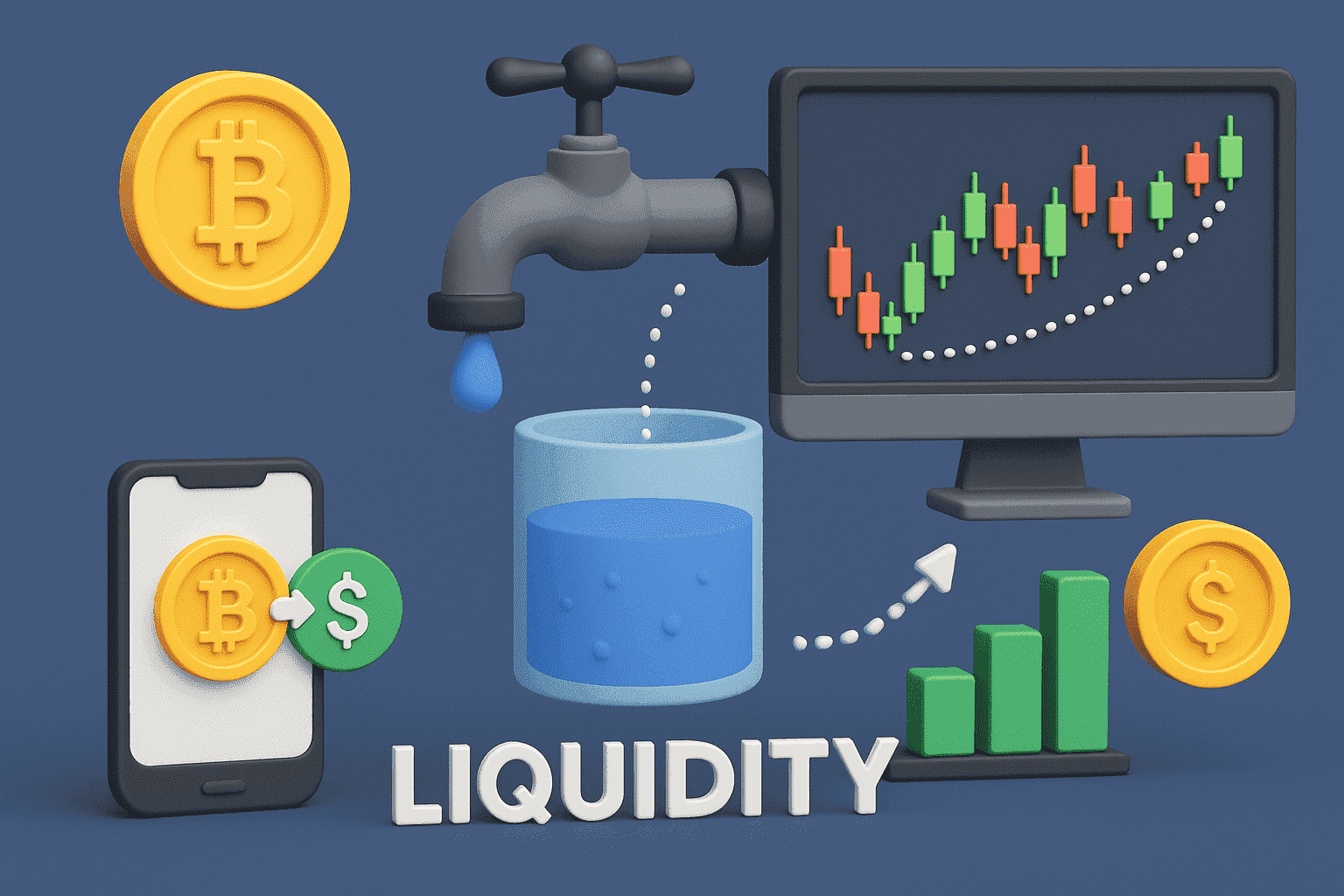Crypto liquidity is a foundational metric that determines how quickly and cost-effectively an asset can be bought or sold without significantly affecting its price. For traders and market makers, high liquidity ensures narrow spreads, minimal slippage, and the ability to execute large orders efficiently. This guide explores the nature of liquidity, key metrics, its impact on trading, differences between CEX and DEX, and offers strategies and tools to optimize your exchange processes.
1. What Is Crypto Liquidity
Crypto liquidity refers to an asset’s ability to be swiftly converted into other currencies (fiat or crypto) while maintaining price stability. Low liquidity can cause even small orders to move the market price, increasing transaction costs for users.
2. Types of Liquidity
2.1 Market Liquidity
Measured by the volume of orders in the order book on centralized exchanges (CEX). It is assessed by the total order volume within ±1% of the current price and the spread width.
2.2 On-chain Liquidity
Found in AMM pools on decentralized exchanges (DEX). It equals the total assets locked in a pool and determines how large an order can execute without causing a drastic price shift.
2.3 Funding Liquidity
Reflects the availability of margin and leverage on spot and derivatives markets. Crucial for traders using margin trading and synthetic positions.
3. Key Liquidity Metrics
- 24h Trading Volume — the total value of all transactions in 24 hours. High volume indicates active buy and sell interest.
- Bid-ask Spread — the difference between the best bid and ask price. A narrower spread indicates higher liquidity.
- Order Book Depth — the volume of orders within ±1% of the price. Essential for estimating price impact of orders.
- Slippage — deviation between the intended and executed price of an order.
- Turnover Ratio — the ratio of trading volume to circulating supply. A higher ratio suggests better liquidity.
- Order Book Imbalance — ratio of bid to ask volumes, indicating directional pressure on price.
4. Factors Influencing Liquidity
Liquidity is shaped by several key factors:
- Market Makers: professional traders or bots placing orders on both sides of the book.
- Volatility: excessive volatility can deter market makers and reduce liquidity.
- Systemic Risks: network forks, hacks, or regulatory actions can sharply reduce liquidity.
- Tokenomics: emission schedules, incentives for liquidity providers, and spread structures in AMM pools.
5. Liquidity on CEX vs DEX
Centralized exchanges (CEX) like Binance and Kraken typically offer deeper order books, tighter spreads, and faster execution, but at the cost of custodial custody. Decentralized exchanges (DEX) such as Uniswap and SushiSwap provide non-custodial trading, but rely on on-chain pools that may have limited liquidity for certain pairs.
6. Tools for Liquidity Analysis
- CoinMarketCap / CoinGecko — basic volume and spread metrics.
- TradingView — depth charts and sentiment indicators.
- Dune Analytics — on-chain AMM pool metrics.
- Tenderly — transaction simulations and slippage assessment.
7. How Liquidity Affects Trading
Low liquidity leads to wide spreads, high slippage, and increased overall trading costs. For example, swapping a large amount (> $50,000) on a shallow DEX pool can consume 3–5% of the trade value due to AMM mechanics. Conversely, deep liquidity on a CEX allows similar trades with minimal price impact.
8. Trade Optimization Strategies
- Use limit orders to lock in your price and avoid excessive slippage.
- Split large orders into smaller chunks to reduce order book impact.
- Trade during peak liquidity times (e.g., 14:00–16:00 UTC).
- Monitor on-chain pools before trading to account for balance changes.
- Implement TWAP or VWAP algorithms for phased order execution.
- Deploy arbitrage bots to exploit spread differences between CEX and DEX.
9. Table 1. Liquidity Metrics Comparison
| Metric | Description | Ideal Value |
|---|---|---|
| 24h Volume | Total trade value per day | > $10M |
| Spread (%) | Bid-ask difference | 0.2% |
| Depth ±1% | Order sum within ±1% | > $1M |
| Slippage (%) | Capture loss on execution | 0.3% |
| Turnover Ratio | Volume / market cap | > 0.1 |
10. Table 2. Pre-trade Checklist
| Step | Action |
|---|---|
| 1 | Check volume and spread on multiple CEX |
| 2 | Assess order book depth |
| 3 | Analyze on-chain DEX pool liquidity |
| 4 | Calculate expected slippage |
| 5 | Set limit or TWAP orders |
| 6 | Monitor mempool for latency |
| 7 | Account for fees (exchange + gas) |
| 8 | Execute small test swap |
11. FAQ
- What is crypto liquidity? It’s an asset’s ability to trade without large price impact.
- How is liquidity measured? Volume, spread, depth, and slippage.
- Why is liquidity important? It minimizes spread and slippage costs.
- How to enhance liquidity? Attract market makers and expand AMM pools.
- Difference between CEX and DEX liquidity? CEX uses order books; DEX relies on AMM pools.
- What is slippage? Price change between order placement and execution.
- How to avoid high slippage? Use limit orders and split large trades.
- Which tools analyze liquidity? CoinGecko, TradingView, Dune, Tenderly.
- When is the best time to trade? During peak liquidity (14:00–16:00 UTC).
- How to check a DEX pool? Inspect on-chain pool balances.
- What is turnover ratio? Volume divided by market cap.
- Where to find trading volume data? On CoinGecko, CoinMarketCap, or exchange APIs.
12. Real-world Savings Examples
- Binance BTC/USDT: >$20M daily volume reduced spreads to 0.05%.
- Uniswap ETH/USDC (Arbitrum): $5M pool liquidity yielded 0.2% slippage.
- Kraken XTZ/BTC: $3M daily volume delivered ~0.1% spreads.
13. Conclusion
Crypto liquidity is critical for all market participants. Detailed metric analysis, using aggregators and on-chain tools, plus strategic trade planning help minimize spreads, slippage, and costs, ensuring maximum efficiency in your transactions.





















